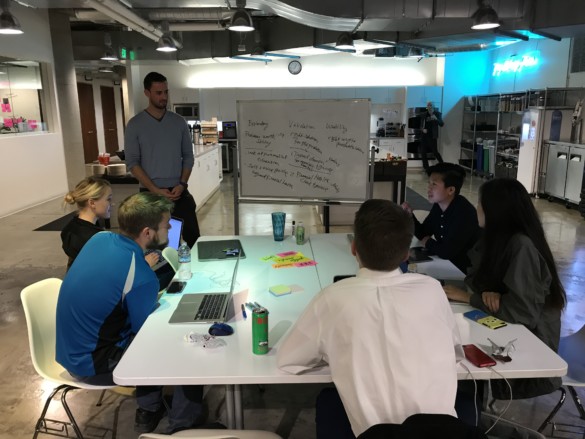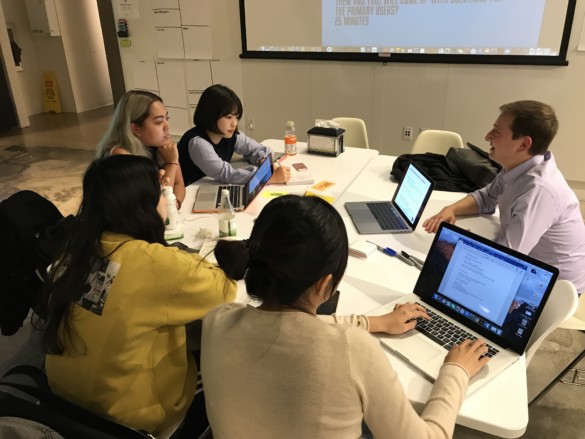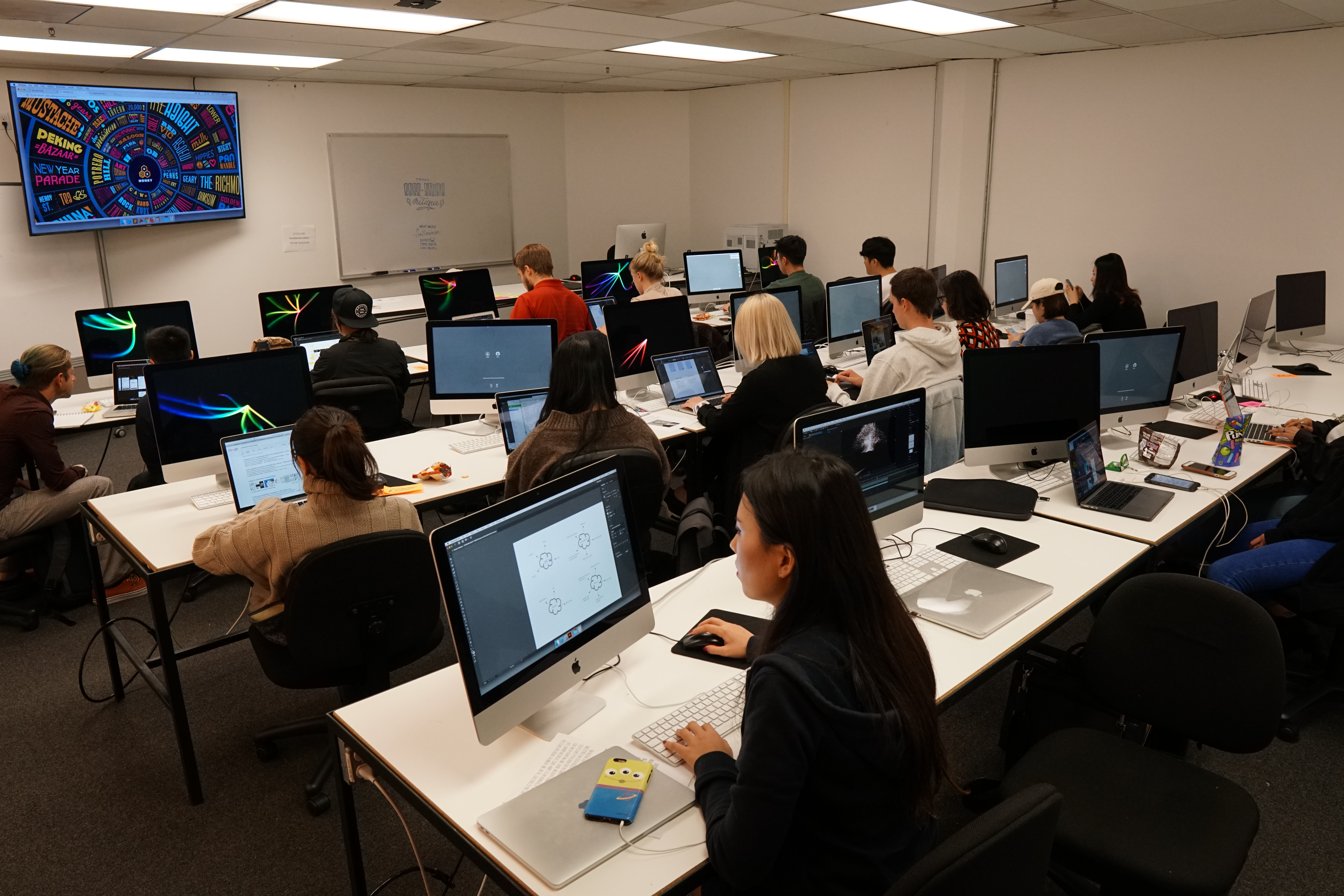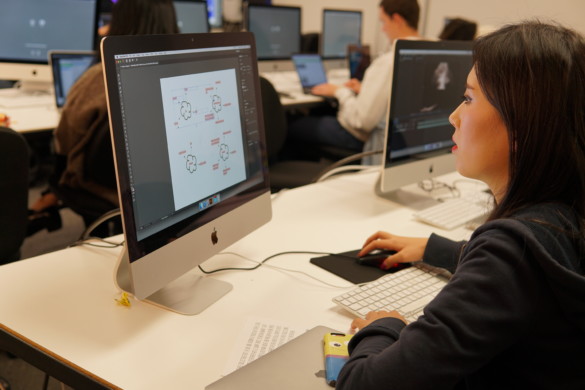New WNM class, Special Topics, Advanced User Experience, gives students first-hand, real-world experience in San Francisco
By Nina Tabios
From Facebook and Twitter to Spotify and Waze, user experience design impacts how well we interact with the technology around us. User experience design, or UX design, encompasses the way you read the news and the reason why you swipe right.
Learning the nuances of UX design has been a vital part of the curriculum at the School of Web Design & New Media (WNM) at Academy of Art University but now a new Special Topics, Advanced User Experience (WNM 499) class led by instructor Aaron Lawrence gives WNM undergrads the opportunity to apply their knowledge directly into San Francisco’s start-up economy.
“The goal is to set students up with what real working experience looks like,” said Lawrence, who is also a product designer at Pivotal Software. “[We want to] give them a safe opportunity to come in and get a little bit of a taste of what it looks like to work with a client before we send them out to the industry.”
“They are working on projects that have a ‘real-world’ result. So naturally the stakes are higher, but also they see that they can—and need to—rely on each other and work as a group to meet the challenge. … And they gain valuable experience in communicating with clients, having to pitch their ideas and receive and apply real feedback,” said Ryan Medieros, WNM and School of Advertising co-director. “Students should put this class on their résumé and add it to their portfolio as an example of ‘real-world’ experience when they interview for internships and jobs.”


There is certainly no shortage of tech entrepreneurs in San Francisco, but Lawrence specifically wanted companies with little to no design help. Sourced through early-stage fund venture 500 Startups, Lawrence’s clientele pool varied in industry (data security, finance education, tax accounting, medical) as well as investment and development stages. B.F.A. WNM student Kathryn Davis and her partner are updating the third rendition of her client’s product, a corporate mentor-mentee app.
“We have to figure out how to use the knowledge we’ve gotten so far in the [WNM] program and how to apply that to help them better their situation,” Davis explained. “You have to work with your partner and client and decide together what comes next, what is most important, deciding priorities of problems and arrange things, which is great [for] the real world.”
Lawrence defined UX design as connecting “user-centered design, which is understanding of user needs, solving problems for people and connecting that with business goals.” He said UX design, in a nutshell, is split into “three buckets of work under two umbrellas.” Strategic is first; research of targeted audience, understanding goals, and problems to solve. This is followed by the tangible—or visual design—to stylize the product. By midterms, highlighted learnings and themes in the case-studies should be wrapped and leaning into problem validation and solution concepts.
“It takes a lot of not only craft development but also strategic thinking to balance out what is proper user experience design,” said Lawrence.

The Special Topics class is the first of its kind for WNM, where students studying UX can apply their knowledge to real-world client campaigns. Photo by Mateo Tayamen.
WNM students first learn these methods in User Experience 1 and 2 (WNM 120 and 290, respectively). But as Davis tells it, designing a UX platform for a business entity proved much more complex than just practicing it in theory within the classroom. A “structure-based” and “by-the-book” student, Davis got a hard lesson in soft skills in her very first client meeting.
“I went into the initial meeting with an understanding of what targets to hit. I was very assertive about it and trying to direct where the problem was going to go,” Davis said. She later realized that she isn’t her own boss in this scenario and that being a professional involved just as much compromise as the actual work does.
“I realized I couldn’t do that and I was being very off-putting,” Davis explained. “There’s got to be an equal give-and-take between you and the client and how you go about solving a problem. You don’t even know the problem yet—how can you even know the trajectory?”
You also can’t have a problem without a case-study. UX designers are tasked with relieving human stresses big and small—WNM 499 student Sara Lundberg’s project addresses the stress of waiting in airport security lines, for example—so the extensive research, user interviews and even longer time studying data to siphon out themes and patterns make the task a little art meets science. A lot of UX design can’t be seen; questions of what do users want and need often lead to more inquiries, but offers a fascinating insight into human behavior. That bit is what led Lundberg from advertising strategy to user experience.
“You and I can feel the same about a certain thing but be two totally different people,” said Lundberg. “You’re dealing with a broad spectrum of information, other people’s perception of the problem, solution, and product. You’re building solutions for real people to use, which is a much different experience than creating something only you understand.”
There is no telling if we’ll see any of the Special Topics projects in an app store any time soon. But Lawrence insists student success doesn’t hinge upon completing a product, especially in 15 weeks. Going through the motions (interacting with real people, calling out real problems, then mapping out business goals) is the core learning for WNM students and if they get uncomfortable in that process, then Lawrence knows his experiment is working.
“Being uncomfortable is good; if you’re comfortable, you may not be learning,” Lawrence explained. “But when you’re uncomfortable, you’re expanding your level of being okay with being uncomfortable and you’re going to succeed in the industry that way. Go along with the struggles; I’m here to support that.”
